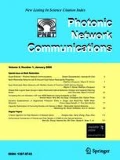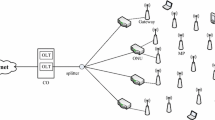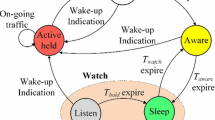Abstract
An ever-increasing bandwidth demand is the main driver to investigate next-generation optical access (NGOA) networks. These networks, however, do not only have to comply with increasing data rates, but they should also meet the societal green agenda. As the access part consumes a major fraction of the energy consumption in today’s fiber-to-the-home-based telecommunication networks, the energy efficiency of NGOA networks should be an important design parameter. In this paper, we present a detailed evaluation of the energy consumption in different NGOA technologies. Furthermore, we analyze the effects of (1) introducing low power modes (e.g., sleep and doze modes) in the various NGOA technologies and (2) using optimal split ratios adjusted to the traffic demands so that the energy consumption is optimized for the desired quality of service level.






Similar content being viewed by others
Notes
In this calculation, a TDM-PON with passive splitters at the remote nodes (like street cabinets) is assumed, meaning that only power is consumed in the ONUs and OLTs. Although some FTTH networks consume power at the remote nodes (like AONs), they only have a minor market share in the current FTTH rollouts.
As aggregation, a 200 Gb/s aggregation switch shared by 100 OLTs is assumed, and as core, several levels of 200 Gb/s IP routers are assumed shared by four aggregation switches at the first level [3].
We define NGOA as a next generation compared to the XG-PON standard and in a 2020 time frame, i.e., technologies that potentially could be deployed by 2020. In this way, NGOA corresponds to an extended version of the currently defined NG-PON2 (i.e., TWDM-PON and WDM-PON).
There are other possible configurations of the line rates for XG-PON, 10G-EPON and GPON in the US direction. Here, a typical example is given.
Power consumption also includes power conversion inefficiency.
For each technology, the memory requirements and thus its associated power consumption may vary. However, its effect is negligible and is thus ignored.
Paper [14] achieves tuning by only heating the wavelengths. However, such advanced solutions are not considered.
Time interval between two successive pollings of an ONU.
A simulation period of 30 s is used, corresponding to a steady-state situation.
References
Dixit, A., Lannoo, B., Colle, D., Pickavet, M., Demeester, P.: ONU power saving modes in next generation optical access networks: progress, efficiency and challenges. Opt. Express 20(26), B52–B63 (2012)
Dixit, A., Lannoo, B., Das, G., Colle, D., Pickavet, M., Demeester, P.: Flexible TDMA/WDMA passive optical network: energy efficient next-generation optical access solution. Opt. Switch. Netw. (OSN) 10(4), 491–506 (2013)
IEEE 802.3av, Power Saving Adhoc Report, Seoul, 15–18 Sep. 2008
Harstead, E., Van Veen, D., Vetter, P.: Technologies for NGPON2: Why I think 40 G TDM PON (XLG-PON) is the clear winner, OFC/NFOEC 2012, Los Angeles, CA, US, March 4–8, (2012)
Chow, H., Suvakovic, D., van Veen, D., Dupas, A., Boislaigue, R., Farah, R., Lau, M. F., Galaro, J., Qua, G., Anthapadmanabhan, N. P., Torfs, G., Praet, C. V., Yin, X., Vetter, P.: Demonstration of low-power bit-interleaving TDM PON, ECOC 2012, Amsterdam, The Netherlands, Sep. 16–20, 2012, p. Mo.2.B.1
Grobe, K., Roppelt, M., Autenrieth, A., Elbers, J.P., Eiselt, M.: Cost and energy consumption analysis of advanced WDM-PONs. IEEE Commun. Mag. 49(2), s25–s32 (2011)
Banerjee, A., Park, Y., Clarke, F., Song, H., Yang, S., Kramer, G., Kim, K., Mukherjee, B.: Wavelength-division-multiplexed passive optical network (WDM-PON) technologies for broadband access: a review [Invited]. J. Opt. Netw. 4(11), 737–758 (2005)
Sanders, R.: The Pareto principle: its use and abuse. J. Prod. Brand Manag. 1(2), 37–40 (1992)
Shi, L., Mukherjee, B., Lee, S.S.: Efficient PON with sleep-mode ONU: progress, challenges, and solutions. IEEE Netw. Mag. 26(2), 36–41 (2012)
ITU-T Rec. G.Sup45, GPON Power Conservation (2009)
Igawa, E., Nogami, M., Nakagawa, J.: Symmetric 10G-EPON ONU Burst-Mode Transceiver Employing Dynamic Power Save Control Circuit’, OFC 2011, Los Angles, CA, US, Mar. 6–10 (2011)
Lambert, S., Lannoo, B., Dixit, A., Colle, D., Pickavet, M., Montalvo, J., Torrijos, J.A., Vetter, P.: Energy efficiency analysis of high speed triple-play services in next-generation PON deployments. Comput. Netw. 78, 68–82 (2015)
Lee, K.-L., Sedighi, B., Tucker, R.S., Chow, H.K., Vetter, P.: Energy efficiency of optical transceivers in fiber access networks [Invited]. J. Opt. Commun. Netw. 4(9), A59–A68 (2012)
Pohlmann, W. et al.: Performance of Wavelength-Set Division Multiplexing PON-Upstream in the O-Band with Optical Preamplification. ECOC, Amsterdam (2012)
Wong, S.-W., Valcarenghi, L., She-Hwa, Y., Campelo, D.R., Yamashita, S., Kazovsky, L.: Sleep mode for energy saving PONs: advantages and drawbacks. IEEE Globecom, Honolulu, HI, US, Nov. 30–Dec. 4 (2009)
Willinger, W., Taqqu, M., Sherman, R., Wilson, D.: Self-similarity through highvariability: statistical analysis of Ethernet LAN traffic at the source level. In: Proceedings of ACM SIGCOMM ’95, pp. 100–113. Cambridge, MA, USA, Aug. (1995)
Acknowledgments
This research is partly funded by the EU FP7 project TREND (ICT-257740). The third author is funded by the Agency for Innovation by Science and Technology in Flanders (IWT). Part of this research is performed in the context of GreenTouch.
Author information
Authors and Affiliations
Corresponding author
Rights and permissions
About this article
Cite this article
Lannoo, B., Dixit, A., Lambert, S. et al. How sleep modes and traffic demands affect the energy efficiency in optical access networks. Photon Netw Commun 30, 85–95 (2015). https://doi.org/10.1007/s11107-015-0504-4
Received:
Accepted:
Published:
Issue Date:
DOI: https://doi.org/10.1007/s11107-015-0504-4




